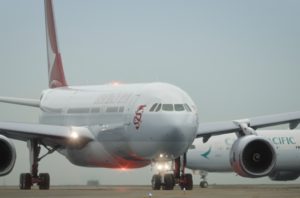 The number of passengers carried and the amount of cargo and mail uplifted by Cathay Pacific and Cathay Dragon in November 2019 both showed decreases year-over-year, according to data released by the Cathay Pacific group.
The number of passengers carried and the amount of cargo and mail uplifted by Cathay Pacific and Cathay Dragon in November 2019 both showed decreases year-over-year, according to data released by the Cathay Pacific group.
The sister airlines carried a total of 2,623,764 passengers last month, a drop of 9.0% compared to November 2018. Passenger load factor decreased by 3.2 percentage points to 80.1%, while capacity decreased by 1.5%, said Cathay Pacific in a release dated December 17.
In the first 11 months of 2019, the number of passengers carried dropped by 0.4% and capacity increased by 5.7%, as compared to the same period for 2018.
The two airlines carried 177,964 tonnes of cargo and mail last month, a drop of 3.9% year-on-year. The cargo and mail load factor fell by 1.5 percentage points to 68.6%. Capacity was down by 3.8% while cargo and mail revenue freight tonne kilometers (RFTKs) dropped by 5.8%.
In the first 11 months of 2019, the tonnage fell by 6.4% against no change in capacity and a 6.8% decrease in RFTKs, as compared to the same period for 2018.
“As with the past few months, November continued to be very challenging for both Cathay Pacific and Hong Kong, with sentiment for travel still weak,” said Cathay Pacific group chief customer and commercial officer Ronald Lam.
In November, inbound Hong Kong traffic dropped 46% compared to the same period in 2018—a further slowdown from the 35% drop seen in October.
Outbound Hong Kong traffic, meanwhile, was down 8% against the same time last year—a slight improvement over previous months.
“Our increasing reliance on transit Hong Kong traffic, which has been less impacted, together with intense competition has meant overall yield remained under significant pressure,” added Lam.
The group’s regional routes, in particular China and Northeast Asia, continued to experience weak demand for travel into Hong Kong. Travel sentiment was also soft on routes to and from the US before Thanksgiving week—traditionally a very strong period for premium class travel.
A few bright spots were the India routes, which remained robust and generated good demand between India and North America. Traffic between Europe and the Southwest Pacific—an important transit passenger stream for the airline’s network—also remained healthy.
“Looking forward, we continue to see a significant shortfall in inbound Hong Kong advance bookings, particularly from mainland China and other regional markets, as compared to the same snapshot last year. This shortfall has been partially offset by the improvement of transit passenger traffic,” said Lam.
As for the cargo business, both load factor and yield further improved against the previous month in November, which is traditionally a peak month of the year. Exports from China, Hong Kong and Taiwan remained robust.
Said Lam: “As demand from traditional retail and new product releases tailed off towards the latter half of the month, strong e-commerce traffic surged around the Singles’ Day shopping holiday in mainland China as well as Black Friday, to which we successfully catered with additional charter requests to Southeast Asia.”
Lam continued that while cargo performance this year remained significantly below the record levels seen in 2018, the company is cautiously optimistic about 2020 despite anticipating a weak first half.
“In our continual efforts to drive the competitiveness of the Hong Kong cargo hub, we were pleased to have announced the introduction of a new Terminal Charge concession for export shipments from Hong Kong, which will take effect from 1 April 2020 and make Cathay Pacific and Hong Kong an even more compelling choice for our cargo customers,” he said.
“Overall, our expectation is that the rest of 2019 will remain incredibly challenging and we continue to expect our second-half financial results to be significantly below those of our first half. As a business we continue to closely monitor market sentiment and global travel trends, remaining agile in our operations and ensuring our passenger and cargo capacity is best aligned with demand.”
In light of the immediate commercial challenges, Lam said the company will reduce seat capacity in 2020 by 1.4% year-on-year as opposed to its original plan of 3.1% growth, “meaning that for the first time in a long while our airlines will reduce in size.”
Photo courtesy of Cathay Pacific
